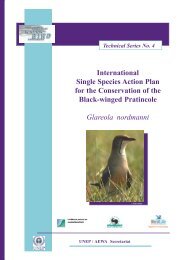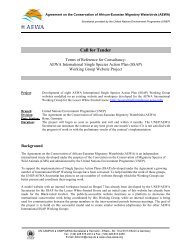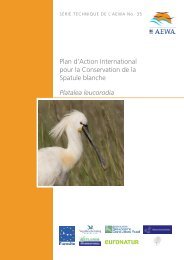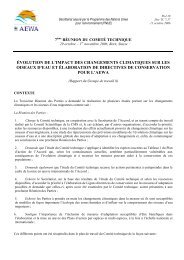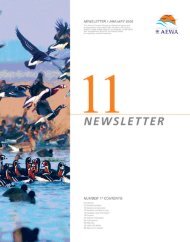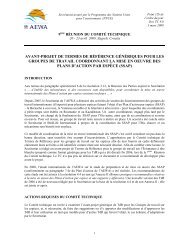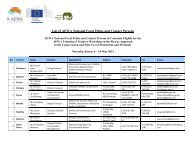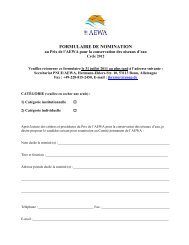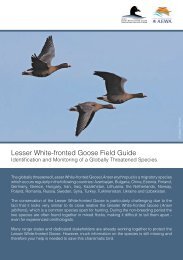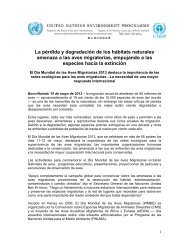International Single Species Action Plan for the ... - AEWA
International Single Species Action Plan for the ... - AEWA
International Single Species Action Plan for the ... - AEWA
Create successful ePaper yourself
Turn your PDF publications into a flip-book with our unique Google optimized e-Paper software.
<strong>AEWA</strong> Technical Series No. 36 - Annexes<br />
Annex 1<br />
Additional biological in<strong>for</strong>mation<br />
Survival and productivity Life cycle Habitat requirements<br />
Almost half of <strong>the</strong> 15 wild Fennoscandian geese<br />
tagged or ringed in Finland/Norway in 1995 and<br />
1996 were shot or probably shot (Markkola, 2005;<br />
Aarvak et al. 1997). The major known causes of<br />
death of released captive-bred birds 1980-1998<br />
were shooting and predation (by mink, Goshawk<br />
Accipiter gentilis, Golden Eagle Aquila<br />
chrysaetos, White-tailed Eagle Haliaeetus<br />
albicilla, fox and dogs). Collision with power lines<br />
was also recorded (Markkola, 2005).<br />
An analysis by Lampila (2001), underlined that<br />
adult mortality and changes in <strong>the</strong> rate of adult<br />
mortality are key factors determining population<br />
trends <strong>for</strong> Lesser White-fronted Goose.<br />
Mean brood size observed at Valdak Marshes (first<br />
autumn staging site <strong>for</strong> <strong>the</strong> Fennoscandian<br />
population) between 1994 and 2000 was 3.2<br />
juveniles (Aarvak & Øien, 2001).<br />
Breeding<br />
Generally arrives on breeding grounds from early<br />
May to late June and departs between mid-August<br />
and September (Madsen 1996). Breeding<br />
behaviour and pre-nesting activity little studied<br />
(Fox 2005). <strong>Single</strong> brood, clutch size 4-6<br />
(exceptionally 1-8), incubation by female <strong>for</strong> 25-<br />
28 days in <strong>the</strong> wild, starting mostly during early<br />
June. Pairs <strong>for</strong>m in 2nd or 3rd year. (Fox 2005).<br />
Moulting<br />
Non-breeding Fennoscandian and Russian birds<br />
undertake moult migration, while breeding birds<br />
moult on <strong>the</strong> breeding grounds. Syroechovskiy<br />
(1996) found that breeding birds in Taimyr<br />
moulted during <strong>the</strong> first week of August, while<br />
non-breeding birds moulted during <strong>the</strong> last 10 days<br />
of July. In <strong>the</strong> Polar Urals and Yamal Peninsula<br />
(Western Siberia) breeding birds moult on <strong>the</strong><br />
breeding grounds from mid-July until <strong>the</strong> first 10<br />
days of August (V. Morozov, pers. comm.)<br />
In 1997 a satellite-tracked bird of <strong>the</strong><br />
Fennoscandian population left <strong>the</strong> breeding<br />
grounds in <strong>the</strong> first half of July and arrived on<br />
Breeding<br />
Breeds in <strong>the</strong> <strong>for</strong>est tundra and sou<strong>the</strong>rn tundra<br />
belts of nor<strong>the</strong>rn Eurasia, with a preference <strong>for</strong><br />
bush tundra interspersed with bogs and lakes<br />
(UNEP/WCMC 2003). Breeding habitat<br />
requirements are different in different parts of <strong>the</strong><br />
distribution range.<br />
A wetland system on <strong>the</strong> mountain plateau of<br />
Finnmark (nor<strong>the</strong>rn Norway) constitutes <strong>the</strong> core<br />
known breeding area <strong>for</strong> <strong>the</strong> species in<br />
Fennoscandia (Øien et al. 2001). A field survey of<br />
part of <strong>the</strong> Kola Peninsula, north-westernmost<br />
Russia, in June 2001 found small numbers of<br />
Lesser White-fronts in an area of mainly treeless<br />
tundra with many lakes, ponds, rivers and streams<br />
and no permanent human settlement (Timonen &<br />
Tolvanen 2004).<br />
In <strong>the</strong> basins of <strong>the</strong> Velt and Neruta rivers, in <strong>the</strong><br />
Malozemelskaya Tundra region of Arctic nor<strong>the</strong>rn<br />
Russia, nest sites were located on river banks with<br />
herb vegetation, mosses, willow (Salix) shrubs and<br />
dwarf birch (Betula nana) sometimes with large<br />
mounds and sand-clay outcrops. The river bottom<br />
was usually stony, often with a wide, sandy<br />
<strong>International</strong> <strong>Single</strong> <strong>Species</strong> <strong>Action</strong> <strong>Plan</strong> Lesser White-fronted Goose –Annexes<br />
I



